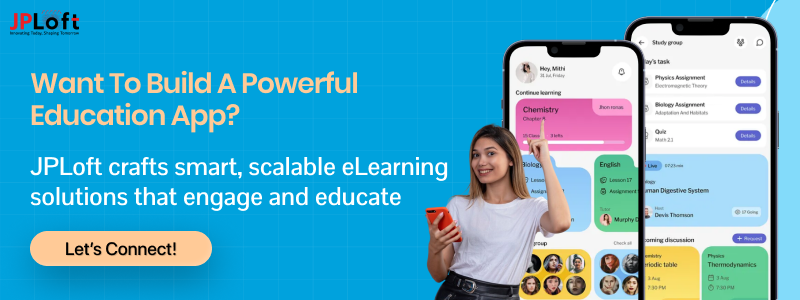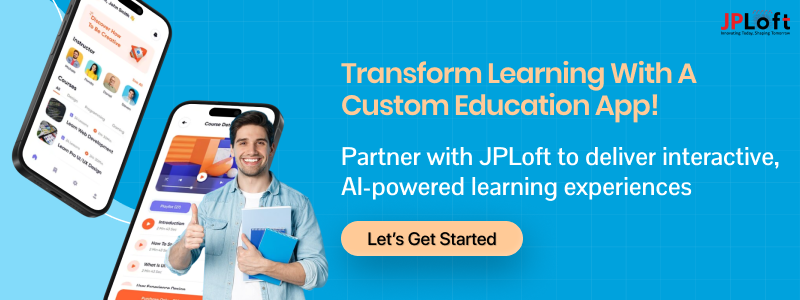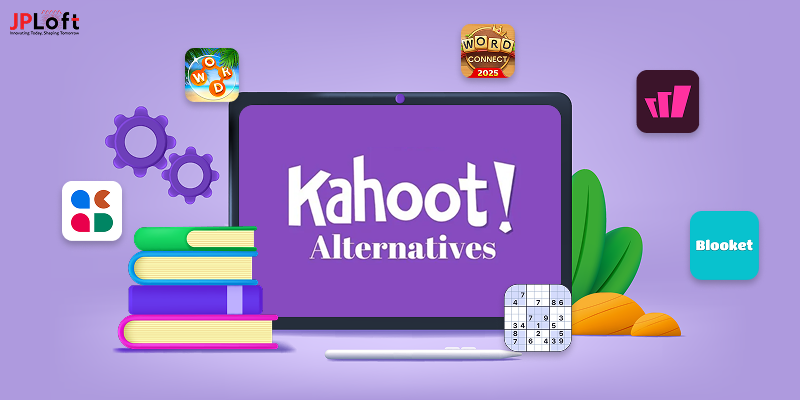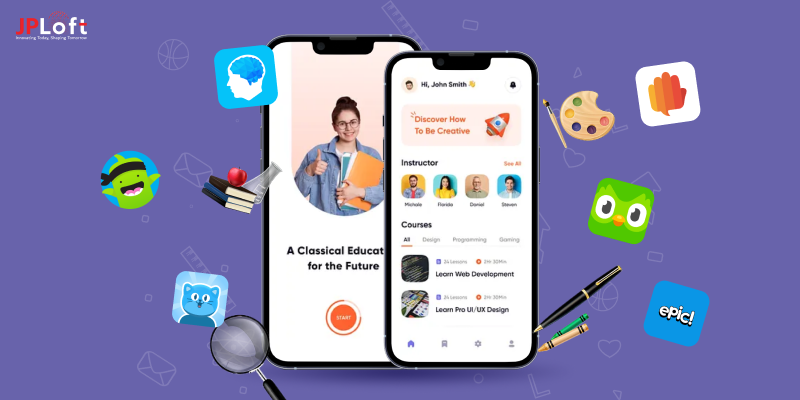Education apps have become a must-have for schools, tutors, and even individual learners. But if you think building one is just about adding a few video lessons and quizzes, think again.
Behind every successful education app lies a long list of technical decisions, content challenges, and user experience hurdles.
Whether you are an edtech startup, a school looking to go online, or a business planning to launch the next big e-learning platform, you'll likely face several roadblocks during development.
From ensuring content security to keeping the app user-friendly for both teachers and students, there’s a lot to manage. In this article, we will walk you through the top education app development challenges and how to overcome them smartly.
Let’s break it down.
What Are Education Apps and How Do They Work?
Education apps are mobile or web-based platforms designed to facilitate learning through digital tools.
These apps help students, teachers, and even parents to access educational content anytime, anywhere. If it’s a language learning app, online tutoring, test preparation, or school management, education apps are transforming the way we learn and teach.
At the core, an education app connects users (students, teachers, or administrators) to a wide range of digital learning resources, like video lessons, notes, quizzes, real-time classes, assignments, and performance analytics.
These apps can be tailored to different age groups and academic levels, making them flexible and highly scalable.
So, how do they work?
Here’s a simplified flow:
-
- User Login & Profiles: Students, teachers, and parents log into the app using their credentials. Each user type gets a customised interface. For example, students see courses and quizzes, while teachers can upload materials and track student progress.
- Content Delivery: The app delivers educational content, such as recorded videos, live lectures, PDFs, or interactive exercises, based on the selected course or subject.
- Assessments & Tracking: Students take tests or assignments through the app. The app then stores performance data, helping both users and teachers track learning progress.
- Live Interaction & Communication: Many apps allow in-app chat, forums, or live classes for real-time interaction. Some even integrate video conferencing tools for virtual classrooms.
- Progress Reports & Feedback: Both students and educators can review performance analytics, teacher feedback, and overall progress through dashboards and reports.
Key Market Statistics for the Education App Industry
The education app industry is growing at an impressive pace, driven by the rising demand for digital learning, remote education, and personalized learning experiences.
Here are some key insights that highlight the market's potential:
-
- The global education apps market was valued at USD 57.35 billion in 2024 and is projected to reach USD 300.49 billion by 2032, growing at a CAGR of 23% from 2025 to 2032.
- In 2023, the educational app sector generated $5.93 billion, marking a 15.1% increase from the previous year.
- Education apps were used by 709 million people and downloaded 939 million times in 2023. Duolingo was the most downloaded app with 175 million downloads.
- The education apps market is expected to grow from USD 203.20 billion in 2025 to USD 410.30 billion by 2034, with a CAGR of 8.12% during the forecast period.
- The e-learning app market is projected to expand from USD 267.5 billion in 2024 to USD 470.1 billion by 2034, growing at a CAGR of 5.8%.
As more students and educators register on these platforms, integrating essential processes like email validation becomes crucial to ensure secure sign-ups, prevent fake accounts, and maintain platform integrity.
In short, top language learning apps for education apps are like mini digital schools that offer a smart, flexible, and interactive way of learning. But as simple as they look from the outside, their development involves overcoming several hurdles.
Let’s explore the top education app development challenges in the next section.
Common Education App Development Challenges And Their Solutions
Developing an education app might seem exciting at first, but when you get into the details, you'll find a variety of hurdles that can slow you down if you're not prepared.
From content engagement to technical complexities, each phase brings its own set of challenges.
Let’s break down some of the common education app development challenges and how you can solve them effectively.
1. Creating Engaging and Interactive Content
This issue tops the list of education app challenges for many edtech businesses. Keeping learners engaged is very challenging. Simply putting text or videos in an app isn’t enough.
Users, especially younger ones, quickly lose interest if content feels dull or repetitive. It is a common development challenge for an education app, especially when trying to make lessons fun yet informative.
Solution:
To solve this, developers can integrate education app features like gamification (points, badges, quizzes), animations, storytelling formats, and micro-learning modules.
Also, interactive tools like drag-and-drop tasks or AR-based lessons can make content more enjoyable. Keeping content aligned with the learner’s level also boosts retention. You can build a mobile app with dynamic content systems that adapt and evolve, making sure the app is as engaging as the classroom.
Tip: Make sure content is modular and adaptable so it can be reused and updated quickly without major rework.
2. Ensuring Personalised Learning Experiences
Each student learns at a different pace and in different ways. One of the top education app development challenges is providing a personalized learning experience that adjusts to every learner’s need.
This becomes a main development challenge of an education app because most apps tend to follow a one-size-fits-all model.
Solution:
Using AI in education apps can track user behavior, performance, and learning style.
Based on that data, the app can recommend lessons, difficulty levels, and even revision content. Personalization features like customizable dashboards, reminders, or language preferences can also help.
Solving this is key to tackling top education app development challenges that affect long-term user retention.
Tip: Start small with simple personalization features and expand as your user data grows.
3. Integrating Real-Time Communication and Live Classes
Ignoring this can lead to some of the biggest development education app challenges down the line.
With remote learning becoming the new normal, it is difficult to ensure smooth real-time communication between teachers and students.
This includes live classes, group discussions, chats, or one-on-one doubt sessions. Poor integration leads to lag, crashes, or unclear audio/video, affecting the user experience.
Solution:
To overcome this, use reliable APIs and SDKs like Zoom, Agora, or Twilio for video and chat functions.
Make sure the app supports multiple bandwidths and has backup options like recorded sessions or chat logs. Proper testing before launch is critical. The best mobile app development company makes sure clients get real-time features that are not only scalable but also stable across devices.
If not handled well, this becomes one of the major challenges while building an education app.
Tip: Always ensure server-side infrastructure is scalable and supports latency-free connections.
4. Data Security and Privacy of Student Information
Protecting user data is the top development challenge of an education app.
Since apps store sensitive student data like names, addresses, grades, and progress reports, a security breach can break user trust and even result in legal trouble. This is one of the most pressing education app development challenges in 2025.
Solution:
To deal with this, make sure your app follows security best practices like end-to-end encryption, secure logins (2FA), and data access restrictions.
Compliance with privacy laws like GDPR or COPPA is also important. Regular audits and penetration testing help identify and fix risks. Develop apps with strong security measures to ensure every byte of student data is safe.
Tip: Be transparent with your privacy policy and allow users control over their data.
5. Managing Offline Access and Data Sync
Many students don’t have reliable internet all the time. One of the common education app development challenges is making sure it works offline too.
Users should be able to continue learning without interruption and sync data once they’re back online. It’s a must-solve challenge while developing an education app for remote regions.
Solution:
To solve this, use local data storage systems like SQLite or Realm. These allow the app to store lessons, quizzes, and progress locally and sync later when the internet is available. Also, design your app to notify users about syncing and avoid data loss.
Building hybrid apps that work both online and offline, making learning continuous and stress-free.
Tip: Prioritize which data needs offline access to keep app performance smooth.
6. Cross-Platform Compatibility and Responsiveness
Imagine launching an app that works perfectly on iPhones but lags on Android devices, or looks great on tablets but crashes on smaller screens.
That’s a major red flag. Ensuring your education app works smoothly across devices and screen sizes is one of the main development challenges of an education app. It impacts user experience directly and can lead to poor reviews and uninstallations.
Solution:
To overcome this, opt for cross-platform frameworks like Flutter or React Native. These allow you to write one codebase and deploy it across both iOS and Android.
Also, implement responsive UI design to adapt to all screen sizes. Run rigorous app testing to make sure your app performs consistently, no matter where it’s used.
Tip: Build device-specific UI elements only when absolutely necessary to avoid bloated code.
7. Incorporating AI and Adaptive Learning Features
Educational apps are now expected to be smart, recommending what to learn next, predicting weak areas, or even adjusting difficulty levels.
However, embedding such intelligence is one of the biggest development challenges in education apps, especially for startups with limited data or budget.
Solution:
Start simple. Use rule-based logic for adaptive content initially, and as your user base grows, collect performance data to train basic AI models.
Tools like TensorFlow Lite or Firebase ML Kit are great for mobile-based AI functions. Businesses gradually scale their AI features so personalization grows with usage.
Tip: AI features shine when they’re subtle, don’t overwhelm users with constant suggestions.
8. Compliance with Educational Standards and Policies
This one is tricky. You might build a fantastic app, but if it doesn’t meet regional educational regulations (like FERPA, COPPA, or GDPR), it can’t be launched or worse, can be taken down.
This makes compliance one of the top development challenges of an education app, especially for apps targeting schools or minors.
Solution:
Start with research. Understand the regulations that apply in your target region and age group.
Partner with educational consultants or legal advisors during planning. Also, build transparent privacy policies and include consent mechanisms for underage users. Create an education app design that aligns with global education standards to ensure smooth approvals and launches.
Tip: Add compliance checks as part of your development sprints, not just at the end.
9. Seamless Integration with Third-Party Tools (LMS, Zoom, Google Classroom)
Many educational institutions already use platforms like Zoom, Google Classroom, or Moodle. Your app should talk to these tools easily. If not, it can be a dealbreaker.
Integration issues are often overlooked but rank high in the list of education app challenges.
Solution:
Use APIs provided by these tools for clean integration. Ensure data sync is secure and complies with both platforms’ privacy rules.
Also, document any third-party dependencies clearly. Develop a mobile app with seamless integration with tools educators already use, making the transition smooth and user-friendly.
Tip: Keep fallback options (like recorded sessions or offline notes) in case third-party tools fail.
10. Accessibility for Special-Needs Learners
Not every learner is the same. Many students rely on assistive technologies like screen readers, voice navigation, or color-contrast adjustments.
Designing for inclusivity is one of the most underrated yet common development challenges for an education app.
Solution:
Follow Web Content Accessibility Guidelines (WCAG) when designing the UI/UX.
Add features like text-to-speech, keyboard navigation, and subtitles. Use readable fonts and allow font resizing. Accessibility should be built in, not bolted on, so from day one, you should focus on inclusive design practices.
Tip: Test your app using accessibility tools (like VoiceOver or TalkBack) before launch.
By understanding and addressing these major education app development challenges, you’ll be better equipped to create an app that not only engages users but also provides a seamless, secure, and adaptive learning experience.
Get Solutions to All Your Challenges With JPLoft by Your Side
Tackling all these top education app development challenges might sound overwhelming, but that’s exactly where JPLoft comes in.
With years of experience as an education app development company, our team knows how to turn complex requirements into seamless learning platforms.
Whether it's ensuring cross-platform performance, integrating AI-powered adaptive learning, maintaining data privacy, or building for accessibility and compliance, we’ve done it all and we do it well.
We don’t just build apps. We create personalized, interactive, and secure digital learning solutions that grow with your users and scale with your vision.
So, if you’re ready to overcome the major development challenges of education app projects and launch something truly impactful, let’s talk.
Wrapping Up
Building a successful education app isn’t just about writing clean code, it’s about understanding real learning needs, solving real-world challenges, and delivering a seamless experience to both students and educators.
From managing cross-platform compatibility to ensuring data privacy and accessibility, every step matters.
By identifying the biggest development challenges in education apps early on, you can plan smarter and build better. And with the right tech partner by your side, even the most complex issues become manageable.
Whether you're an edtech startup or an established education brand, we are here to help you overcome these challenges and turn your app idea into a powerful digital learning platform.
Let’s build something that educates, empowers, and evolves, together.
FAQs
To make your education app engaging, consider integrating gamification, interactive content (like quizzes, badges, and challenges), and adaptive learning features that adjust to user progress. These elements keep users motivated and invested in the learning process.
To ensure cross-platform compatibility, use frameworks like Flutter or React Native. These allow you to maintain a single codebase that works across iOS and Android devices. Additionally, always test your app on multiple devices to ensure smooth performance.
Data security is vital because education apps handle sensitive student data, including personal details and academic records. To protect this information, ensure compliance with data privacy laws (such as GDPR or FERPA), and implement encryption, secure logins, and regular security audits.
AI can be integrated into your education app by using adaptive learning algorithms to recommend personalized content, track progress, and predict areas where students may need additional help. This creates a more personalized and effective learning experience.
Compliance with educational standards and privacy laws, such as FERPA, COPPA, and GDPR, is essential when developing an education app. These laws protect student data and ensure your app meets legal requirements, especially if you're targeting minors or educational institutions.













Share this blog